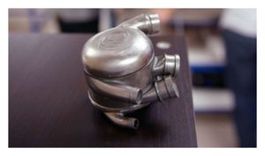| © BiVACOR | Scientists at the Texas Heart Institute claim that they are co-developing a bionic heart that can perfectly replicate the function of its biological counterpart, but without actually beating. The researchers, who are working on the heart along with Houston-based private-sector medical research and engineering firm BiVACOR, told ABC News that the average human heart needs to beat 42 million times per year. An artificial heart that had all of the moving parts required to beat would wear out in a hurry, BiVACOR chief medical officer Dr. William Cohn said. |
The new bionic heart would only have one moving part and would transport blood through the body using magnets instead of pumping it, they explained. A prototype that has been used in large animals allows them to live for a month and even exercise on a treadmill for one month before they are culled to examine its impact on their brain and other organs.
"The device has performed in many respects better than any artificial heart anybody has come up with in the last 50 years," Cohn told ABC News, noting that he and his colleagues consider it the "first legitimate shot... for a permanent mechanical replacement for the failing human heart." He added that "kidney function, lung function, everything works beautifully throughout."
While the device, which is approximately half the size of a soda can, is implanted in a patient's chest, it has a battery-operated controller that remains outside his or her body, a recent Lubbock Online blog said. It features a spinning disk with fins suspended by a pair of magnetic fields that prevent it from touching anything, and rotates an estimated 2,000 to 3,000 times a minute.
Leave it to the Aussies
According to the Houston Chronicle, the bionic heart was first designed by Australian engineer Daniel Timms and was further developed by Dr. Cohn. Its disk remains flat by undergoing 20,000 micro-adjustments per second, and since the left and right sides of the heart work harder under different circumstances, it adjusts the balance 20 times per second. As Dr. Cohn, who is also a heart surgeon at the Institute, told the newspaper, "People bring in suitcases all the time with these devices, and by and large it's a lot of crap. When Daniel came in I realized almost immediately this was the mostly highly evolved and brilliant device I've ever seen. I immediately told him he should move to Houston."
Go check out their Kickhearter
Earlier this month, the team developing the beatless heart told The Courier-Journal that they hope to have the device fully operational and ready for use in human patients by 2020, but that the device first needed to pass rigorous and expensive tests to prove it worked and was safe. To help cover the costs of those tests, the Brisbane's Prince Charles Hospital Foundation has launched a campaign to raise $5 million to help prepare the heart for human trials by 2018, the Australian newspaper added. The potential cost of the final device is not yet known.
"We are taking-on evolution, we have never had anyone alive without a pulse and a lot of people thought that could never be done," cardiac expert John Fraser said during a recent fundraising event, The Courier-Journal said. "Evolution developed us with a pulse but we don't need one." "The pump... has got no pulse, it has a spinning disk levitated by magnets, very much like the Japanese trains levitated by magnets... there is no wear (and tear). There have been devices before that support one side of the heart... where you don't have a pulse, but this is something that can entirely replace the heart," he added, noting that the device could last two decades.
Source

 RSS Feed
RSS Feed